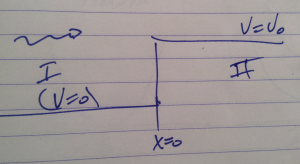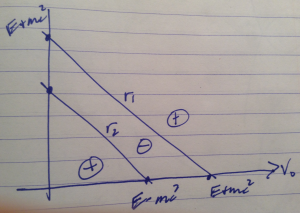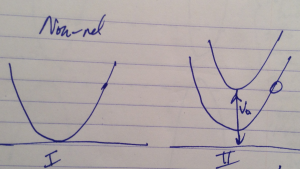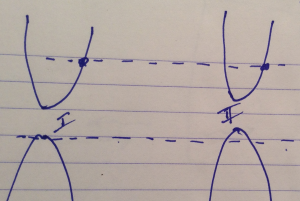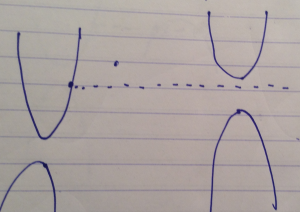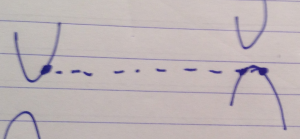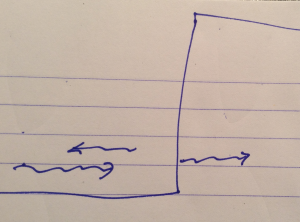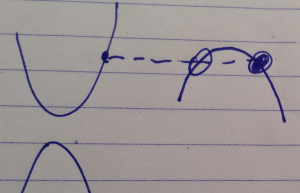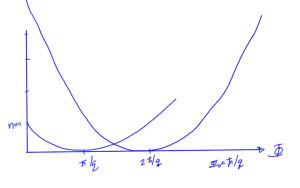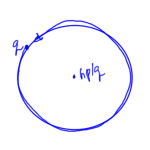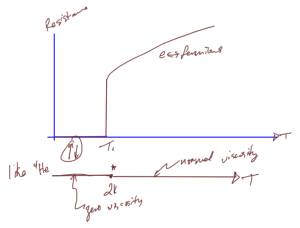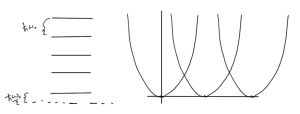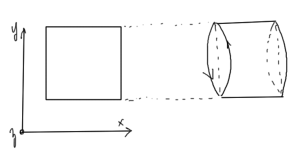[Click here for a PDF of an older version of post with nicer formatting]. Updates will be made in my old grad quantum notes.
In problem 1.17 of [2] we are to show that non-commuting operators that both commute with the Hamiltonian, have, in general, degenerate energy eigenvalues. That is
\begin{equation}\label{eqn:angularMomentumAndCentralForceCommutators:320}
[A,H] = [B,H] = 0,
\end{equation}
but
\begin{equation}\label{eqn:angularMomentumAndCentralForceCommutators:340}
[A,B] \ne 0.
\end{equation}
Matrix example of non-commuting commutators
I thought perhaps the problem at hand would be easier if I were to construct some example matrices representing operators that did not commute, but did commuted with a Hamiltonian. I came up with
\begin{equation}\label{eqn:angularMomentumAndCentralForceCommutators:360}
\begin{aligned}
A &=
\begin{bmatrix}
\sigma_z & 0 \\
0 & 1
\end{bmatrix}
=
\begin{bmatrix}
1 & 0 & 0 \\
0 & -1 & 0 \\
0 & 0 & 1 \\
\end{bmatrix} \\
B &=
\begin{bmatrix}
\sigma_x & 0 \\
0 & 1
\end{bmatrix}
=
\begin{bmatrix}
0 & 1 & 0 \\
1 & 0 & 0 \\
0 & 0 & 1 \\
\end{bmatrix} \\
H &=
\begin{bmatrix}
0 & 0 & 0 \\
0 & 0 & 0 \\
0 & 0 & 1 \\
\end{bmatrix}
\end{aligned}
\end{equation}
This system has \( \antisymmetric{A}{H} = \antisymmetric{B}{H} = 0 \), and
\begin{equation}\label{eqn:angularMomentumAndCentralForceCommutators:380}
\antisymmetric{A}{B}
=
\begin{bmatrix}
0 & 2 & 0 \\
-2 & 0 & 0 \\
0 & 0 & 0 \\
\end{bmatrix}
\end{equation}
There is one shared eigenvector between all of \( A, B, H \)
\begin{equation}\label{eqn:angularMomentumAndCentralForceCommutators:400}
\ket{3} =
\begin{bmatrix}
0 \\
0 \\
1
\end{bmatrix}.
\end{equation}
The other eigenvectors for \( A \) are
\begin{equation}\label{eqn:angularMomentumAndCentralForceCommutators:420}
\begin{aligned}
\ket{a_1} &=
\begin{bmatrix}
1 \\
0 \\
0
\end{bmatrix} \\
\ket{a_2} &=
\begin{bmatrix}
0 \\
1 \\
0
\end{bmatrix},
\end{aligned}
\end{equation}
and for \( B \)
\begin{equation}\label{eqn:angularMomentumAndCentralForceCommutators:440}
\begin{aligned}
\ket{b_1} &=
\inv{\sqrt{2}}
\begin{bmatrix}
1 \\
1 \\
0
\end{bmatrix} \\
\ket{b_2} &=
\inv{\sqrt{2}}
\begin{bmatrix}
1 \\
-1 \\
0
\end{bmatrix},
\end{aligned}
\end{equation}
This clearly has the degeneracy sought.
Looking to [1], it appears that it is possible to construct an even simpler example. Let
\begin{equation}\label{eqn:angularMomentumAndCentralForceCommutators:460}
\begin{aligned}
A &=
\begin{bmatrix}
0 & 1 \\
0 & 0
\end{bmatrix} \\
B &=
\begin{bmatrix}
1 & 0 \\
0 & 0
\end{bmatrix} \\
H &=
\begin{bmatrix}
0 & 0 \\
0 & 0
\end{bmatrix}.
\end{aligned}
\end{equation}
Here \( \antisymmetric{A}{B} = -A \), and \( \antisymmetric{A}{H} = \antisymmetric{B}{H} = 0 \), but the Hamiltonian isn’t interesting at all physically.
A less boring example builds on this. Let
\begin{equation}\label{eqn:angularMomentumAndCentralForceCommutators:480}
\begin{aligned}
A &=
\begin{bmatrix}
0 & 1 & 0 \\
0 & 0 & 0 \\
0 & 0 & 1
\end{bmatrix} \\
B &=
\begin{bmatrix}
1 & 0 & 0 \\
0 & 0 & 0 \\
0 & 0 & 1
\end{bmatrix} \\
H &=
\begin{bmatrix}
0 & 0 & 0 \\
0 & 0 & 0 \\
0 & 0 & 1 \\
\end{bmatrix}.
\end{aligned}
\end{equation}
Here \( \antisymmetric{A}{B} \ne 0 \), and \( \antisymmetric{A}{H} = \antisymmetric{B}{H} = 0 \). I don’t see a way for any exception to be constructed.
The problem
The concrete examples above give some intuition for solving the more abstract problem. Suppose that we are working in a basis that simultaneously diagonalizes operator \( A \) and the Hamiltonian \( H \). To make life easy consider the simplest case where this basis is also an eigenbasis for the second operator \( B \) for all but two of that operators eigenvectors. For such a system let’s write
\begin{equation}\label{eqn:angularMomentumAndCentralForceCommutators:160}
\begin{aligned}
H \ket{1} &= \epsilon_1 \ket{1} \\
H \ket{2} &= \epsilon_2 \ket{2} \\
A \ket{1} &= a_1 \ket{1} \\
A \ket{2} &= a_2 \ket{2},
\end{aligned}
\end{equation}
where \( \ket{1}\), and \( \ket{2} \) are not eigenkets of \( B \). Because \( B \) also commutes with \( H \), we must have
\begin{equation}\label{eqn:angularMomentumAndCentralForceCommutators:180}
H B \ket{1}
= H \sum_n \ket{n}\bra{n} B \ket{1}
= \sum_n \epsilon_n \ket{n} B_{n 1},
\end{equation}
and
\begin{equation}\label{eqn:angularMomentumAndCentralForceCommutators:200}
B H \ket{1}
= B \epsilon_1 \ket{1}
= \epsilon_1 \sum_n \ket{n}\bra{n} B \ket{1}
= \epsilon_1 \sum_n \ket{n} B_{n 1}.
\end{equation}
We can now compute the action of the commutators on \( \ket{1}, \ket{2} \),
\begin{equation}\label{eqn:angularMomentumAndCentralForceCommutators:220}
\antisymmetric{B}{H} \ket{1}
=
\sum_n \lr{ \epsilon_1 – \epsilon_n } \ket{n} B_{n 1}.
\end{equation}
Similarly
\begin{equation}\label{eqn:angularMomentumAndCentralForceCommutators:240}
\antisymmetric{B}{H} \ket{2}
=
\sum_n \lr{ \epsilon_2 – \epsilon_n } \ket{n} B_{n 2}.
\end{equation}
However, for those kets \( \ket{m} \in \setlr{ \ket{3}, \ket{4}, \cdots } \) that are eigenkets of \( B \), with \( B \ket{m} = b_m \ket{m} \), we have
\begin{equation}\label{eqn:angularMomentumAndCentralForceCommutators:280}
\antisymmetric{B}{H} \ket{m}
=
B \epsilon_m \ket{m} – H b_m \ket{m}
=
b_m \epsilon_m \ket{m} – \epsilon_m b_m \ket{m}
=
0,
\end{equation}
The sums in \ref{eqn:angularMomentumAndCentralForceCommutators:220} and \ref{eqn:angularMomentumAndCentralForceCommutators:240} reduce to
\begin{equation}\label{eqn:angularMomentumAndCentralForceCommutators:500}
\antisymmetric{B}{H} \ket{1}
=
\sum_{n=1}^2 \lr{ \epsilon_1 – \epsilon_n } \ket{n} B_{n 1}
=
\lr{ \epsilon_1 – \epsilon_2 } \ket{2} B_{2 1},
\end{equation}
and
\begin{equation}\label{eqn:angularMomentumAndCentralForceCommutators:520}
\antisymmetric{B}{H} \ket{2}
=
\sum_{n=1}^2 \lr{ \epsilon_2 – \epsilon_n } \ket{n} B_{n 2}
=
\lr{ \epsilon_2 – \epsilon_1 } \ket{1} B_{1 2}.
\end{equation}
Since the commutator is zero, the matrix elements of the commutator must all be zero, in particular
\begin{equation}\label{eqn:angularMomentumAndCentralForceCommutators:260}
\begin{aligned}
\bra{1} \antisymmetric{B}{H} \ket{1} &= \lr{ \epsilon_1 – \epsilon_2 } B_{2 1} \braket{1}{2} = 0 \\
\bra{2} \antisymmetric{B}{H} \ket{1} &= \lr{ \epsilon_1 – \epsilon_2 } B_{2 1} \braket{1}{1} \\
\bra{1} \antisymmetric{B}{H} \ket{2} &= \lr{ \epsilon_2 – \epsilon_1 } B_{1 2} \braket{1}{2} = 0 \\
\bra{2} \antisymmetric{B}{H} \ket{2} &= \lr{ \epsilon_2 – \epsilon_1 } B_{1 2} \braket{2}{2}.
\end{aligned}
\end{equation}
We must either have
- \( B_{2 1} = B_{1 2} = 0 \), or
- \( \epsilon_1 = \epsilon_2 \).
If the first condition were true we would have
\begin{equation}\label{eqn:angularMomentumAndCentralForceCommutators:300}
B \ket{1}
=
\ket{n}\bra{n} B \ket{1}
=
\ket{n} B_{n 1}
=
\ket{1} B_{1 1},
\end{equation}
and \( B \ket{2} = B_{2 2} \ket{2} \). This contradicts the requirement that \( \ket{1}, \ket{2} \) not be eigenkets of \( B \), leaving only the second option. That second option means there must be a degeneracy in the system.
References
[1] Ronald M. Aarts. Commuting Matrices, 2015. URL http://mathworld.wolfram.com/CommutingMatrices.html. [Online; accessed 22-Oct-2015].
[2] Jun John Sakurai and Jim J Napolitano. Modern quantum mechanics. Pearson Higher Ed, 2014.
